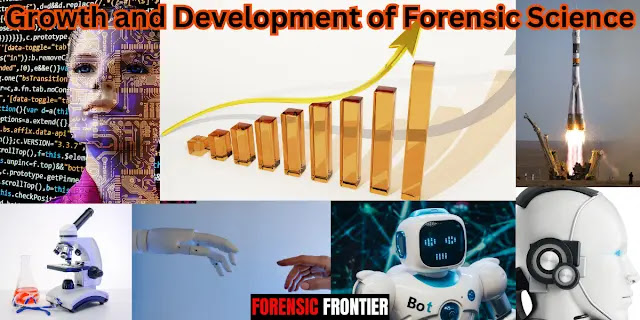Growth and Development of Forensic Science Laboratories
Forensic science, the application of scientific principles to legal investigations, has come a long way in its development, evolving from its earliest establishments to a network of state-of-the-art laboratories across the globe. Let's explore the significant milestones in the growth of forensic science laboratories and how they have contributed to crime investigation worldwide.
Chronological Order of the Growth and Development of Forensic Science:
1. 1849 - Chemical Examiner Laboratory, Madras2. 1853 - Chemical Examiner laboratory, Kolkata
3. 1864 - Chemical Examiner laboratory, Agra
4. 1870 - Chemical Examiner laboratory, Bombay
5. 1892 - Anthropometric Bureau, Calcutta
6. 1897 - Fingerprint Bureau, Calcutta
7. 1898 - Inspectorate Of Explosive, Nagpur
8. 1905 - Central Finger Print bureau (CFPB), Shimla
9. 1906 - Government Examiner Questioned Documents (GEQD), Shimla
10. 1910 - Serological and chemical examiner to the Government of India, Calcutta
11. 1910 - Most states in India established Finger Print Bureaux
12. 1915 - Footprint Section of Criminal Investigation Department, Bengal
13. 1917 - Note Forgery Section in Criminal Investigation Department, Bengal
14. 1923 - First Forensic Science Laboratory established in Los Angeles
15. 1930 - Ballistics Laboratory, Calcutta
16. 1935 - Metropolitan Forensic Science Laboratory established at Scotland Yard, UK
17. 1936 - Scientific Sections in the Criminal Investigation Department, Bengal
18. 1950 - Introduction of Criminology in India
19. 1952 - State Forensic Science Laboratory, Calcutta
20. 1955 - Central Fingerprint Bureau (CFPB), Calcutta
21. 1956 - Central Detective Training School (CDTS), Calcutta
22. 1957 - Central Forensic Science Laboratory, Calcutta
23. 1958 - State Forensic Science Laboratory (SFSL), Mumbai
24. 1956 - Constitution of Central Advisory Committee
25. 1959 - Sagar University, Madhya Pradesh
26. 1960 - Indian Academy of Forensic Science (IAFS)
27. 1964 - Central Detective Training School, Hyderabad
28. 1967 - CFSL, Hyderabad
29. 1968 - Central Forensic Science Laboratory (CFSL), (CBI) New Delhi
30. 1969-70 - Federal Scheme for financial assistance for state
31. 1970 - Bureau of Police Research and Development (BPR&D), New Delhi
32. 1972 - Institute of Criminology and Forensic Science,New Delhi
33. 1972 - Indian Academy Of Forensic Medicine, Goa
34. 1972 - CDTS, Hyderabad
35. 1974 - Andhra Pradesh Forensic Science Laboratory (combined) established1978 - CFSL, Chandigarh
36. 1983 - Recommendations of Scientific Advisory Committee to the Cabinet
37. 1994 - AFIS (Automated Fingerprint Identification System)
38. 2002 - Directorate of Forensic Science Services (DFSS), CGO Complex, New Delhi
39. 2010 - DFS renamed as Directorate of Forensic science services(DFSS)
40. 2011 - CFSL Pune, Bhopal and Guwahati
41. 2012 - CDTS Jaipur
42. 2016 - CDTS Ghaziabad
43. 2019 - CFSL, Kamrup, Guwahati
44. 2019- A.P. Forensic Science Laboratory, Andhra Pradesh
45. 2019-T. S.
Forensic Science Laboratory Telangana
Conclusion
The growth and development of forensic science
laboratories have been a remarkable journey, reflecting the advancements in
technology and the increasing need for scientific analysis in crime
investigation. From the first laboratory established in Los Angeles in 1923 to
the present network of over a thousand laboratories worldwide, forensic science
has played a pivotal role in bringing justice to victims and solving complex
criminal cases. As technology continues to progress, forensic science will
undoubtedly continue to evolve, empowering investigators with even more
powerful tools in the pursuit of truth and justice.




.webp)


%20(1).webp)
.webp)


%20(1).webp)

%20(1)%20(1).webp)


%20(1).webp)
0 Comments
If you have any doubts, let me know.